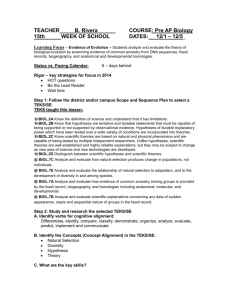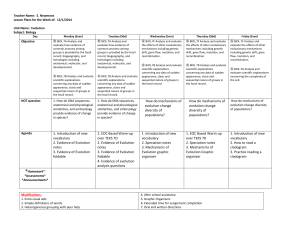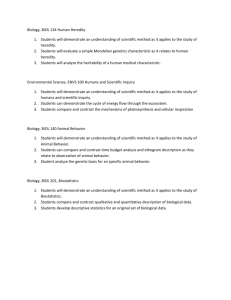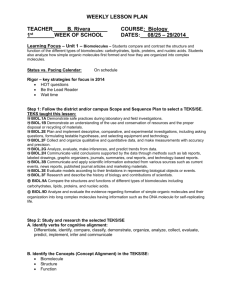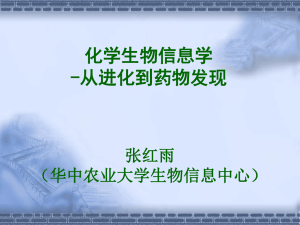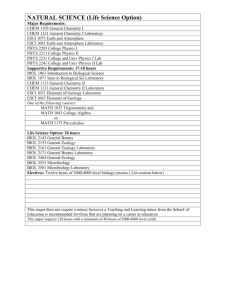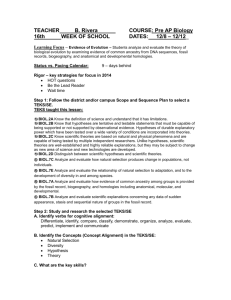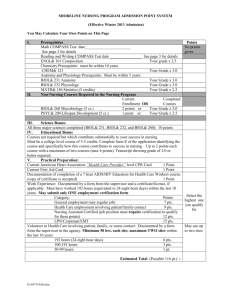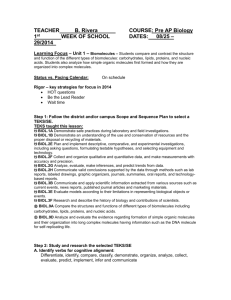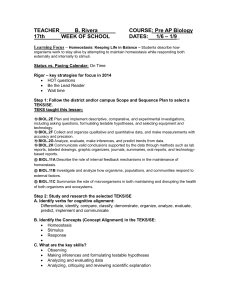TEACHER B. Rivera COURSE: Pre AP Biology 15th WEEK OF
advertisement
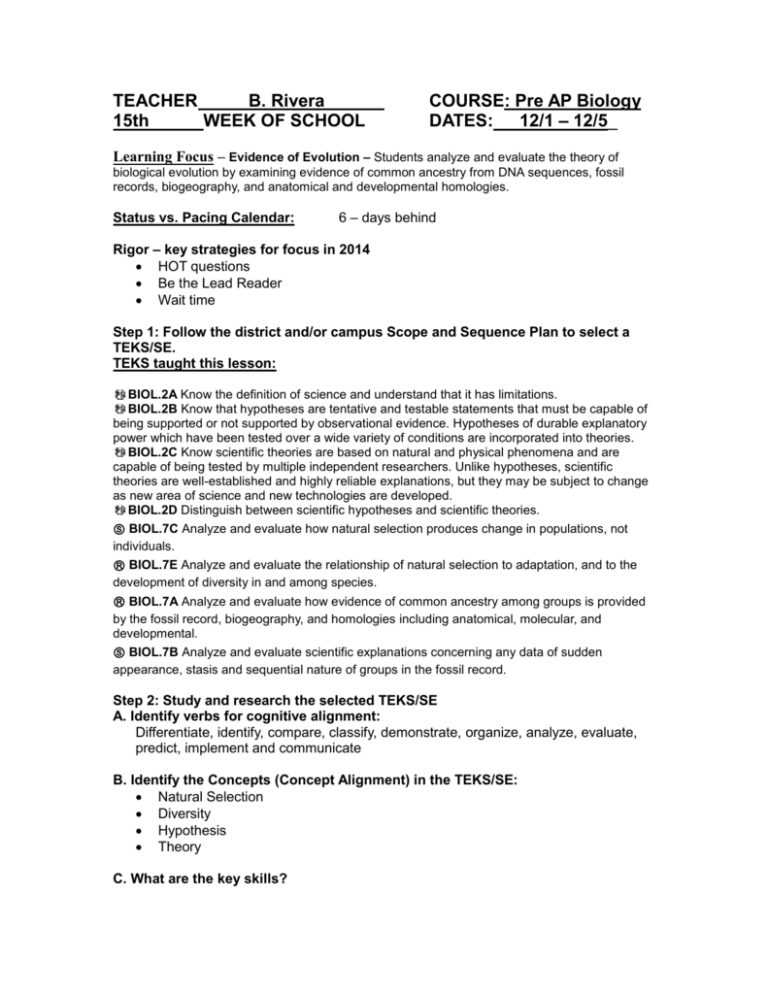
TEACHER B. Rivera 15th WEEK OF SCHOOL COURSE: Pre AP Biology DATES: 12/1 – 12/5_ Learning Focus – Evidence of Evolution – Students analyze and evaluate the theory of biological evolution by examining evidence of common ancestry from DNA sequences, fossil records, biogeography, and anatomical and developmental homologies. Status vs. Pacing Calendar: 6 – days behind Rigor – key strategies for focus in 2014 HOT questions Be the Lead Reader Wait time Step 1: Follow the district and/or campus Scope and Sequence Plan to select a TEKS/SE. TEKS taught this lesson: BIOL.2A Know the definition of science and understand that it has limitations. BIOL.2B Know that hypotheses are tentative and testable statements that must be capable of being supported or not supported by observational evidence. Hypotheses of durable explanatory power which have been tested over a wide variety of conditions are incorporated into theories. BIOL.2C Know scientific theories are based on natural and physical phenomena and are capable of being tested by multiple independent researchers. Unlike hypotheses, scientific theories are well-established and highly reliable explanations, but they may be subject to change as new area of science and new technologies are developed. BIOL.2D Distinguish between scientific hypotheses and scientific theories. Ⓢ BIOL.7C Analyze and evaluate how natural selection produces change in populations, not individuals. Ⓡ BIOL.7E Analyze and evaluate the relationship of natural selection to adaptation, and to the development of diversity in and among species. Ⓡ BIOL.7A Analyze and evaluate how evidence of common ancestry among groups is provided by the fossil record, biogeography, and homologies including anatomical, molecular, and developmental. Ⓢ BIOL.7B Analyze and evaluate scientific explanations concerning any data of sudden appearance, stasis and sequential nature of groups in the fossil record. Step 2: Study and research the selected TEKS/SE A. Identify verbs for cognitive alignment: Differentiate, identify, compare, classify, demonstrate, organize, analyze, evaluate, predict, implement and communicate B. Identify the Concepts (Concept Alignment) in the TEKS/SE: Natural Selection Diversity Hypothesis Theory C. What are the key skills? Observing Making inferences and formulating testable hypotheses Analyzing and evaluating data Analyzing, critiquing and reviewing scientific explanation D. What are the vocabulary Words in the TEKS/SE: a. Academic – DNA fossil homology biogeography embryology evidence phenomena stasis phylogeny analogous structure ancestry sequential homologous structure vestigial structure Step 3: Using the results from above list the critical components of an aligned lesson in science. What are the critical components of aligned lessons in teaching this TEKS/SE to the depth and complexity of STAAR/ EOC? The theory of biological evolution can be explained by evidence of common ancestry provided by DNA and molecular biology, the fossil record, biogeography, and anatomical and developmental homologies. 1. How do DNA sequences, anatomical and physiological similarities, and embryology provide evidence of change in species? 2. How does the fossil record provide evidence of common ancestry among groups of organisms? 3. Why is the study of evolution important? Step 4: Using the list of critical components from Step 3, go on a “Treasure Hunt” through programs, textbooks, and materials to find the most aligned lesson or lessons. Monday 12/1 TEKS: 1. BIOL.2G BIOL.2H 2. Ⓡ BIOL.6F 3. Ⓢ BIOL.6G 4. 5. Tuesday 12/2 TEKS: BIOL.2A BIOL.2B BIOL.2D Objective: Students will examine evidence of evolution and evaluate speciation and the reproductive barriers that exist in nature. Engage and connect Review: 5 Mechanisms of Microevolution Guided instruction – PowerPoint Lecture: Natural Selection (pt. 2) Independent practice – Notes Check for understanding – Discussion Homework –– Read: The Difference between Theory and Hypothesis hand out Complete vocabulary words and definitions for unit. 1. Objective: Review: Students will be able to examine existing evidence and identify key components regarding hypothesis and scientific theory. 2. Engage and connect What’s your theory on… 3. Guided instruction – Lecture regarding the scientific method and vocabulary and how they differ from social expression. BIOL.2C Ⓢ BIOL.7C Wednesday 12/3 TEKS: Independent practice – Notes and class participation 4. Check for understanding – Question and answer student based inquiry. 5. Homework – Complete missing assignments 1. 2. 3. 4. 5. Objective: Students will analyze the different methods used in producing evidence of evolution and how these fields of study apply scientific data to explain their findings. Engage and connect: None Guided instruction – Lecture and notes regarding embryology, molecular biology, biogeography, fossils and comparative anatomy. Independent practice – Notes Check for understanding – Questions and class participation Homework –Complete Evidence of Evolution worksheet. Thursday 12/4 TEKS: 1. Objective: Review: Students will examine the need for variation among species and how mate selection is used to produce viable offspring. 2. Engage and connect: Watch video: Why Sex? (PBS documentary) 3. Guided instruction – None Independent practice – Complete worksheet using key points in the video 4. Check for understanding – Identify examples not shown in video using personal experience. 5. Homework –Complete video and worksheet Evolution – Why Sex? – PBS Documentary (name of video) https://www.youtube.com/watch?v=Wns5OQR74OQ Friday 12/5 TEKS: 1. 2. 3. 4. 5. Objective: Students will learn about Linnaeus and the importance of taxonomic classification. Engage and connect: What are cat tails? Guided instruction – PowerPoint presentation: Taxonomy Independent practice – Notes Check for understanding – Questions and class participation Homework –Complete Taxonomic worksheet: Due Monday Upon request by any special needs student, they can receive additional time to complete their assignments. Also, I am available to provide additional assistance to any student who requests it. Depending on their specific request or my assessment of their involvement and understanding of the subject matter in the classroom, special needs students are given preferential seating. Worksheets are used to prepare for each major test. How will you assess learning and mastery? Daily Observations during student group and independent work time, lab work, and board work Class participation and involvement in discussions and labs Weekly Homework Labs, Focus Activities, and/or tests Demonstrations or Labs: Lab Activities – TBD Test: TBD

